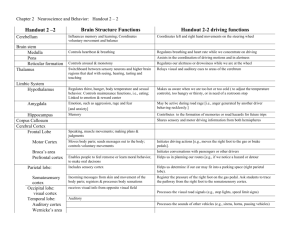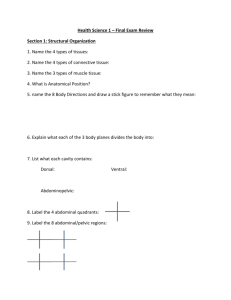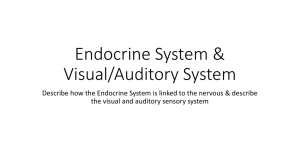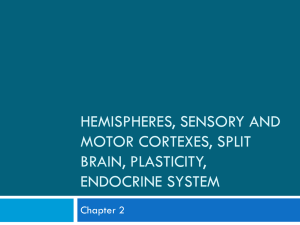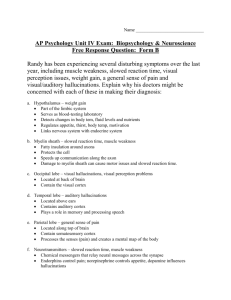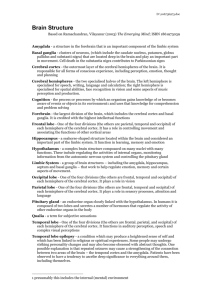Brain Structures and Their Functions
advertisement
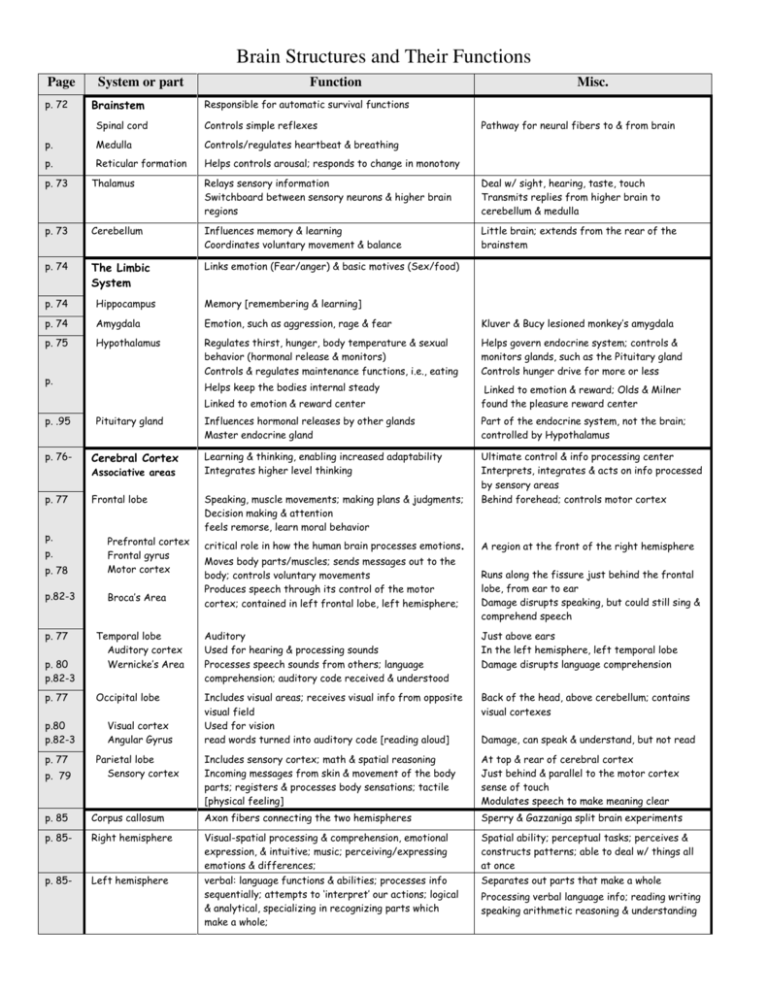
Brain Structures and Their Functions Page p. 72 System or part Brainstem Function Misc. Responsible for automatic survival functions Spinal cord Controls simple reflexes p. Medulla Controls/regulates heartbeat & breathing p. Reticular formation Helps controls arousal; responds to change in monotony Pathway for neural fibers to & from brain p. 73 Thalamus Relays sensory information Switchboard between sensory neurons & higher brain regions Deal w/ sight, hearing, taste, touch Transmits replies from higher brain to cerebellum & medulla p. 73 Cerebellum Influences memory & learning Coordinates voluntary movement & balance Little brain; extends from the rear of the brainstem p. 74 The Limbic System Links emotion (Fear/anger) & basic motives (Sex/food) p. 74 Hippocampus Memory [remembering & learning] p. 74 Amygdala Emotion, such as aggression, rage & fear Kluver & Bucy lesioned monkey’s amygdala p. 75 Hypothalamus Regulates thirst, hunger, body temperature & sexual behavior (hormonal release & monitors) Controls & regulates maintenance functions, i.e., eating Helps govern endocrine system; controls & monitors glands, such as the Pituitary gland Controls hunger drive for more or less Helps keep the bodies internal steady Linked to emotion & reward center Linked to emotion & reward; Olds & Milner found the pleasure reward center Influences hormonal releases by other glands Master endocrine gland Part of the endocrine system, not the brain; controlled by Hypothalamus Cerebral Cortex Learning & thinking, enabling increased adaptability Integrates higher level thinking Frontal lobe Speaking, muscle movements; making plans & judgments; Decision making & attention feels remorse, learn moral behavior Ultimate control & info processing center Interprets, integrates & acts on info processed by sensory areas Behind forehead; controls motor cortex p. p. .95 p. 76- Pituitary gland Associative areas p. 77 p. p. 78 Prefrontal cortex Frontal gyrus Motor cortex p.82-3 Broca’s Area p. p. 77 p. 80 p.82-3 p. 77 p.80 p.82-3 p. 77 p. 79 critical role in how the human brain processes emotions. Moves body parts/muscles; sends messages out to the body; controls voluntary movements Produces speech through its control of the motor cortex; contained in left frontal lobe, left hemisphere; A region at the front of the right hemisphere Runs along the fissure just behind the frontal lobe, from ear to ear Damage disrupts speaking, but could still sing & comprehend speech Temporal lobe Auditory cortex Wernicke’s Area Auditory Used for hearing & processing sounds Processes speech sounds from others; language comprehension; auditory code received & understood Just above ears In the left hemisphere, left temporal lobe Damage disrupts language comprehension Occipital lobe Includes visual areas; receives visual info from opposite visual field Used for vision read words turned into auditory code [reading aloud] Back of the head, above cerebellum; contains visual cortexes Includes sensory cortex; math & spatial reasoning Incoming messages from skin & movement of the body parts; registers & processes body sensations; tactile [physical feeling] At top & rear of cerebral cortex Just behind & parallel to the motor cortex sense of touch Modulates speech to make meaning clear Visual cortex Angular Gyrus Parietal lobe Sensory cortex Damage, can speak & understand, but not read p. 85 Corpus callosum Axon fibers connecting the two hemispheres Sperry & Gazzaniga split brain experiments p. 85- Right hemisphere p. 85- Left hemisphere Visual-spatial processing & comprehension, emotional expression, & intuitive; music; perceiving/expressing emotions & differences; verbal: language functions & abilities; processes info sequentially; attempts to ‘interpret’ our actions; logical & analytical, specializing in recognizing parts which make a whole; Spatial ability; perceptual tasks; perceives & constructs patterns; able to deal w/ things all at once Separates out parts that make a whole Processing verbal language info; reading writing speaking arithmetic reasoning & understanding The Endocrine System and Its Functions p.94-5 Endocrine System Hypothalamus Pituitary gland Secretes many different hormones, some of which affect other glands Thyroid Affects metabolism, among other things Parathyroid Helps regulate the level of calcium in the blood Adrenal glands Inner part, called the medulla, helps trigger the “fight or flight” response Pancreas Regulates the level of sugar in the blood Ovaries Secretes female sex hormones Testis Secretes male sex hormones


